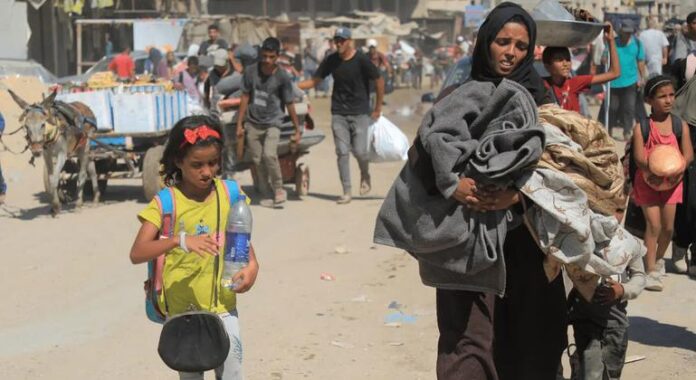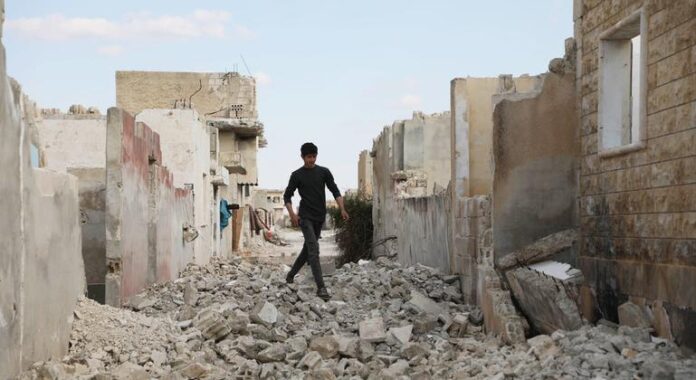European Commission Speech Dubrovnik, 29 May 2025 Dear Boris, Dear Kristalina, ladies and gentlemen. Thank you for the opportunity to participate in this important and timely conference, and for the honour of a… Source link
Speech by Commissioner Lahbib on Preparedness and Strengthening Civil Defence in the EU
European Commission Speech Brussels, 02 Jun 2025 It is a pleasure to be with you in beautiful Stockholm. As Commissioner for Preparedness, I hear a lot about Sweden. You set the gold standard for preparedness … Source link
European Week Against Cancer: supporting patients, from prevention to treatment
This week marks European Week Against Cancer (25-31 May). Under its Europe’s Beating Cancer Plan, the EU has provided support to millions of people affected by cancer across the Union. It funds actions on cancer prevention, detection, diagnosis and treatment to improve patients’ outcomes. Source link
European Week Against Cancer: supporting patients, from prevention to treatment
This week marks European Week Against Cancer (25-31 May). Under its Europe’s Beating Cancer Plan, the EU has provided support to millions of people affected by cancer across the Union. It funds actions on cancer prevention, detection, diagnosis and treatment to improve patients’ outcomes.
Getting ready to support wildfire-hit countries during the summer
The EU has put together teams of firefighters and aircraft to help European countries affected by wildfires during the upcoming summer. Throughout July and August almost 650 firefighters from 14 European countries will be strategically prepositioned in key high-risk locations. Source link
Getting ready to support wildfire-hit countries during the summer
The EU has put together teams of firefighters and aircraft to help European countries affected by wildfires during the upcoming summer. Throughout July and August almost 650 firefighters from 14 European countries will be strategically prepositioned in key high-risk locations.
Gazans’ suffering goes on amid intensifying Israeli strikes
In occupied East Jerusalem, meanwhile, Israeli protesters illegally entered a compound of the UN agency for Palestine refugees, UNRWA.
The development comes after the Israeli military coordination unit COGAT said on Saturday that 388 trucks had entered Gaza since last Monday – the first aid to arrive in well over two months of blockade that have caused hunger levels to spike.
Humanitarians have repeatedly warned that at least 500 to 600 trucks need to cross into Gaza every day to provide people with their daily needs – as they did before war erupted on 7 October 2023 after Hamas-led terror attacks on Israel.
Token assistance
“We are on the back of 11 weeks of nothing entering the Gaza Strip, no food, no medicines for 11 weeks, nothing apart from bombs,” said James Elder, a spokesperson for the UN Children’s Fund (UNICEF).
“And so today, a week after life-saving aid was finally allowed into Gaza again, the scale of that aid is painfully inadequate,” he told UN News. “It looks like a token that appears more like cynical optics than any real attempt to tackle the soaring hunger crisis among children and civilians in Gaza.”
Today, Gazans remain at “critical risk of famine”, UN-backed food security experts warned earlier this month. In their latest update, they estimated that one in five people in Gaza – 500,000 – faces starvation.
Another school hit
Reports on Monday indicated meanwhile that Israel’s intensifying military operation in northern Gaza against alleged terrorists and their infrastructure had killed at least 50 people in air strikes.
One attack hit a school in Gaza City sheltering hundreds of people uprooted by more than 19 months of violence. Footage reportedly taken after the incident showed the silhouette of a child stumbling through a classroom set ablaze at Fahmi al-Jarjawi school.
Another air strike hit a home elsewhere in Gaza City killing four people, according to the health authorities.
UN-run shelters are now “overwhelmed with displaced people desperately seeking safety”, the UN agency for Palestinian refugees (UNRWA) said in an update on Monday. It also underscored that the lack of food has added to people’s suffering.
“Many families are sheltering in abandoned, unfinished, or damaged buildings,” the agency explained. “Sanitation conditions are dire; in some cases, hundreds of people are having to share a single toilet. Others, including children and pregnant women, are sleeping in the open.”
Farming smashed
Across Gaza, less than five per cent of the Strip’s cropland remains available for cultivation, according to UN Food and Agriculture Organization (FAO) and the United Nations Satellite Centre (UNOSAT).
Using high-definition imagery, the agencies’ findings emphasize just how much food production capacity has shrunk in Gaza because of the war, exacerbating the risk of famine.
As of April 2025, more than 80 per cent of the Gaza Strip’s total cropland area has been damaged (12,537 hectares out of 15,053) and 77.8 percent is not accessible to farmers, leaving just 688 hectares (4.6 percent) available for cultivation.
The situation is particularly critical in Rafah and in the northern governorates, where nearly all cropland is not accessible.
Settler protest
Following the protest at the UNRWA compound in occupied East Jerusalem on Monday, a spokesperson for the UN agency noted that one member of the Israeli Knesset had joined the settlers inside the gates. Monday is a national holiday in Israel, marking the moment following the Six-Day War in 1967 when the country’s troops occupied East Jerusalem and the West Bank.
The UNRWA facility – located in the Sheikh Jarrah neighbourhood of occupied East Jerusalem – has been targeted in past arson attacks that set light to the perimeter fence.
At the end of January, UNRWA withdrew its staff from the compound in protest at the entry into force of an Israeli law banning the agency’s operations in occupied East Jerusalem.
The location retains its status as a UN facility that is protected under international law.
Frontex Executive Director Hans Leijtens Participated in European Police Congress 2025 Panel on Migration and Security
The Executive Director of Frontex, Hans Leijtens, took part in the 2025 European Police Congress in Berlin, highlighting the Agency’s growing role in shaping a united European approach to migration and internal security.
Syrians face staggering needs amid insecurity and healthcare crisis
Wrapping up a visit to the country, Edem Wosornu, who heads operations and advocacy for the UN humanitarian affairs coordination office (OCHA) said that she could “feel the momentum for change” on the ground after years of suffering and hardship under the Assad regime ended with its overthrow last December.
But formidable challenges remain as 16.5 million Syrians require humanitarian assistance and protection, and needs are “staggering”.
Speaking from Gaziantep, a humanitarian hub in Türkiye just across the Syrian border, Ms. Wosornu noted an “encouraging trend of returns” since last December.
Over one million internally displaced people have come back to their areas of origin, she said, and more than half a million refugees have returned from neighbouring countries according to the UN refugee agency (UNHCR).
Devastated homes and opportunities
The OCHA official cited insecurity, damaged homes, inadequate services, lack of livelihood opportunities and the threat of unexploded ordnance as “key barriers” preventing people returning.
“People say, first and foremost they want security,” she stressed.
While the level of hostilities in the country has subsided, Ms. Wosornu said, localized tensions and clashes remain a “major concern”.
Remnants of heavy fighting pose a continued threat to civilians, said Dr Altaf Musani, the UN World Health Organization (WHO)’s Director of Health Emergencies.
He pointed to at least 909 casualties from unexploded ordnance since December 2024, including some 400 deaths – a majority of them women and children.
“We’re starting to see the admission rates and consultation rates in emergency rooms increase… Children and women, going about their daily life, trying to get water, trying to get food, trying to rebuild,” are walking through agricultural land, roads and rivers where unexploded munitions could be hiding, he said.
Camp residents at highest risk
Diseases, such as cholera and acute watery diarrhoea, are spreading, Dr. Musani said, stressing that more than 1,444 suspect cases of cholera and seven associated deaths have been recorded.
“This is particularly in Latakia and Aleppo, particularly around displacement camps,” he said.
“We know that when cholera gets hold in camps, it can serve as a brush fire, increasing both morbidity and mortality.”
The WHO official warned that more than 416,000 children in Syria are at risk from severe malnutrition and that more than half of children under five suffering from severe acute malnutrition are not receiving treatment.
“From a public health standpoint, we need to be able to watch that risk and intervene and save those children,” he said.
Boys play in an informal camp in Syria.
Pregnancy dangers
Dr. Musani also noted that half of the maternity hospitals in northwest Syria have suspended operations since September 2024 owing to financial cuts, which humanitarians are “witnessing globally” but which are “really apparent” in Syria.
Underfunding of the humanitarian operation in Syria is already severe. Earlier this week, OCHA’s Coordination Division head, Ramesh Rajasingham, told the Security Council that out of the $2 billion required for the UN and its partners to reach eight million of the most vulnerable people from January through June 2025, only 10 per cent has been received.
The country’s cash-strapped health facilities face a lack of skilled workers and equipment, said WHO’s Dr. Musani. The war had pushed some 50 to 70 per cent of the health workforce to leave the country in search of other opportunities, and the health infrastructure is in dire need of investment.
The WHO official noted that for the health system – the “heartbeat of the nation” – the sanctions imposed on the country during the Assad regime had resulted in a lack of much-needed upgrades, compromising the purchase of new MRI machines, CT scanners, laboratory equipment and software upgrades.
Over the past two weeks, both the United States and the European Union have moved to lift the sanctions. OCHA’s Ms. Wosornu expressed hope that thanks to this development “we’ll see the impact on goods and services, on the cost of doing operations in the country, on the ability to move goods quicker into the country”.
But “it will take time”, she added. “I believe the people of Syria are hopeful that this will change their everyday lives.”
Statement by the High Representative on behalf of the EU on the alignment of certain countries with Council Decision concerning restrictive measures in respect of actions undermining or threatening the territorial integrity, sovereignty and independence…
Statement by the High Representative on behalf of the EU on the alignment of certain countries with Council Decision concerning restrictive measures in respect of actions undermining or threatening the territorial integrity, sovereignty and independence of Ukraine.








